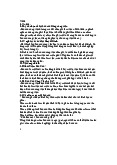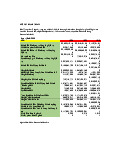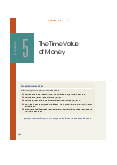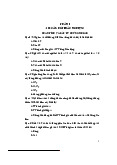




Preview text:
13.
John and Karen are both considering buying a corporate bond with a coupon rate of 8%, a
face value of $1,000, and a maturity date of January 1, 2025. Which of the following statements is most correct? a.
Because both John and Karen will receive the same cash flows if they each buy a
bond, they both must assign the same value to the bond. b.
If John decides to buy the bond, then Karen will also decide to buy the bond, if markets are efficient. c.
John and Karen will only buy the bonds if the bonds are rated BBB or above. d.
John may determine a different value for a bond than Karen because each investor
may have a different level of risk aversion, and hence a different required return. 14.
Shafer Corporation issued callable bonds. The bonds are most likely to be called if: a. Interest rates decrease b. Interest rates increase c.
Shafer Corporation needs additional financing d.
Shafer Corporation’s stock price increases dramatically 15.
Which of the following statements is most correct? a.
If a bond's yield to maturity exceeds its coupon rate, the bond's current yield
(interest yield) must also exceed its coupon rate. b.
If a bond's yield to maturity exceeds its coupon rate, the bond's price must be less than its maturity value. c.
If two bonds have the same maturity, the same yield to maturity, and the same
level of risk, the bonds should sell for the same price regardless of the bond's coupon rate. d.
Answers (b) and (c) are correct. 16.
Zevo Corp. bonds have a coupon rate of 7%, a yield to maturity of 10%, a face value of
$1,000, and mature in 10 years. Which of the following statements is most correct? a.
An investor who purchases the bond today will earn a return of 10% if he sells the bond after one year. b.
An investor who purchases the bond today will earn a return of 7% if he sells the bond after one year. c.
An investor who purchases the bond today will earn a return of 17% per year if he
holds the bond until it matures. d.
An investor who purchases the bond today will earn a return of 10% per year if he
holds the bond until it matures. 17.
A corporate bond has a coupon rate of 10%, a yield to maturity of 12%, a face value of
$1,000, and a market price of $900. Therefore, the annual interest payment is: a. $90 b. $108 c. $120 d. $100 18.
A bond issued by Carris, Inc. 10 years ago has a coupon rate of 6% and a face value of
$1,000. The bond will mature in 5 years. What is the value (to the nearest dollar) to an investor with a required return of 8%? a. $829 b. $920 c. $1,000 d. $1,060 19.
Which of the following statements concerning bonds and risk is true? a.
Because the interest payments and maturing value are known, the only risk
associated with investing in bonds is default risk. b.
Zero coupon bonds are always more risky than bonds with high coupon rates
because of the time value of money. c.
Bonds are generally less risky than common stock because of the preference for
debt over equity in the event of bankruptcy and liquidation. d.
B-rated bonds are above average for risk, i.e., less risky than the average bond. 20.
All of the following affect the value of a bond except: a.
investors' required rate of return b.
the recorded value of the firm's assets c. the coupon rate of interest d. the maturity date of the bond 21.
If the market price of a bond decreases, then: a.
the yield to maturity decreases b. the coupon rate increases c.
the yield to maturity increases d. the coupon rate decreases 22.
Reebop, Inc. expects its current annual $2 per share common stock dividend to remain
the same for the foreseeable future. Therefore, the value of the stock to an investor with a required return of 10% is: a. $0.20 b. $2.00 c. $20.00 d.
$0, because the growth rate is zero. 23.
Which of the following changes will make the value of a stock go up, other things being held constant? a. The required return decreases b. The required return increases c.
In general, investors become more risk averse d.
The growth rate of dividends decreases 24.
If two firms have the same current dividend and the same expected growth rate, their
stocks must sell at the same current price or else the market will not be in equilibrium. a. True b. False c.
True if markets are semi-strong form efficient d.
True if investors are risk-averse 25.
Which of the following statements concerning the constant growth dividend valuation model is true? a.
The required rate of return must exceed the growth rate. b.
The dividend growth rate must be bigger than 10%. c.
The growth rate must increase every year. d.
The required rate of return must be equal to the growth rate for dividends. 26.
Using the constant growth dividend valuation model and assuming dividends will growth
a constant rate forever, the increase in the value of the stock each year should be equal to the a. growth rate in dividends, g b.
required return on the stock, kcs c.
dividend yield plus the capital gains yield d. dividend yield 27.
JKE Company just paid a dividend of $2 per share. Future dividends are expected to
grow at a constant rate of 8% per year. What is the value of the stock if the required return is 10%? a. $10.80 b. $21.60 c. $100.00 d. $108.00 28.
All of the following affect the value of a share of common stock except: a. the par value of stock b.
investors’ required rate of return c. the future growth in dividends d. the future dividends 29.
Soledad Company preferred stock has a market price of $20. If it has a yearly dividend of
$1.50, what is your expected rate of return if you purchase the stock at its market price? a. .075% b. 7.5% c. 13.31% d. 21.33% 30.
Which of the following is not true regarding common stock? a.
Dividends, unlike interest payments, are not tax deductible. b.
Common stock, unlike bond principal, does not mature. c.
Common stockholders are owners of the firm, whereas bondholders are creditors. d.
Dividend payments, like interest payments, are fixed. Problems (10 points each) 1.
QPT paid a $3 per share dividend yesterday. The dividend is expected to grow at 7
percent per year for the foreseeable future. QPT has a beta of 1.6, a standard deviation of returns
of 28 percent, and a required return of 19%. What is the value of a share of QPT common stock? 2.
You are considering the purchase of Zappa Company stock. You anticipate that the
company will pay dividends of $2.00 per share next year and $2.25 per share the following year.
You believe that you can sell the stock for $17.50 per share two years from now. If your
required rate of return is 12 percent, what is the maximum price that you would pay for a share of Zappa Company stock? 3.
Miller/Hershey's preferred stock is selling at $54 on the market and pays an annual dividend of $4.20 per share. a.
What is the expected rate of return on the stock? b.
If an investor's required rate of return is 9%, what is the value of the stock to that investor? c.
Considering the investor's required rate of return, does this stock seem to be a desirable investment? 4.
A bond with a $1,000 face value and a 9 percent annual coupon pays interest annually. The bond matures in 12 years. a.
Determine the value of the bond to a friend of yours with a required rate of return of 11%. b.
A zero coupon bond with similar risk is selling for $300. The bond has a face
value of $1,000 and matures in 12 years. Your friend asks you which bond she should invest in,
the zero coupon bond or the bond in part (a). Which bond do you recommend, and why?
Assume the market price of the bond in part (a) is $720. 5.
KPR's $1,000 par value bonds currently sell for $798.50. The coupon rate is 10 percent,
paid semi-annually. If the bonds have 5 years before maturity, what is the yield to maturity on the bonds? 6.
Vertex bonds have a maturity value of $1,000. The bonds carry a coupon rate of 14
percent. Interest is paid semi- annually. The bonds will mature in seven years. If the current market price is $1,092.65,
a. what is the yield to maturity on the bond?
b. what is the current yield on the bond? Answer key: 13 D 14 A 15 B 16 D 17 D 18 B 19 C 20 B 21 C 22 C 23 A 24 B 25 A 26 A 27 D 28 A 29 B 30 D Problems: 1. $26.75 5. 16% 2. $17.53 6. a) 12% b) 12.81% 3. a) 7.78% b) $46.67 c) No 4. a) $870.15 b) 10.55%




